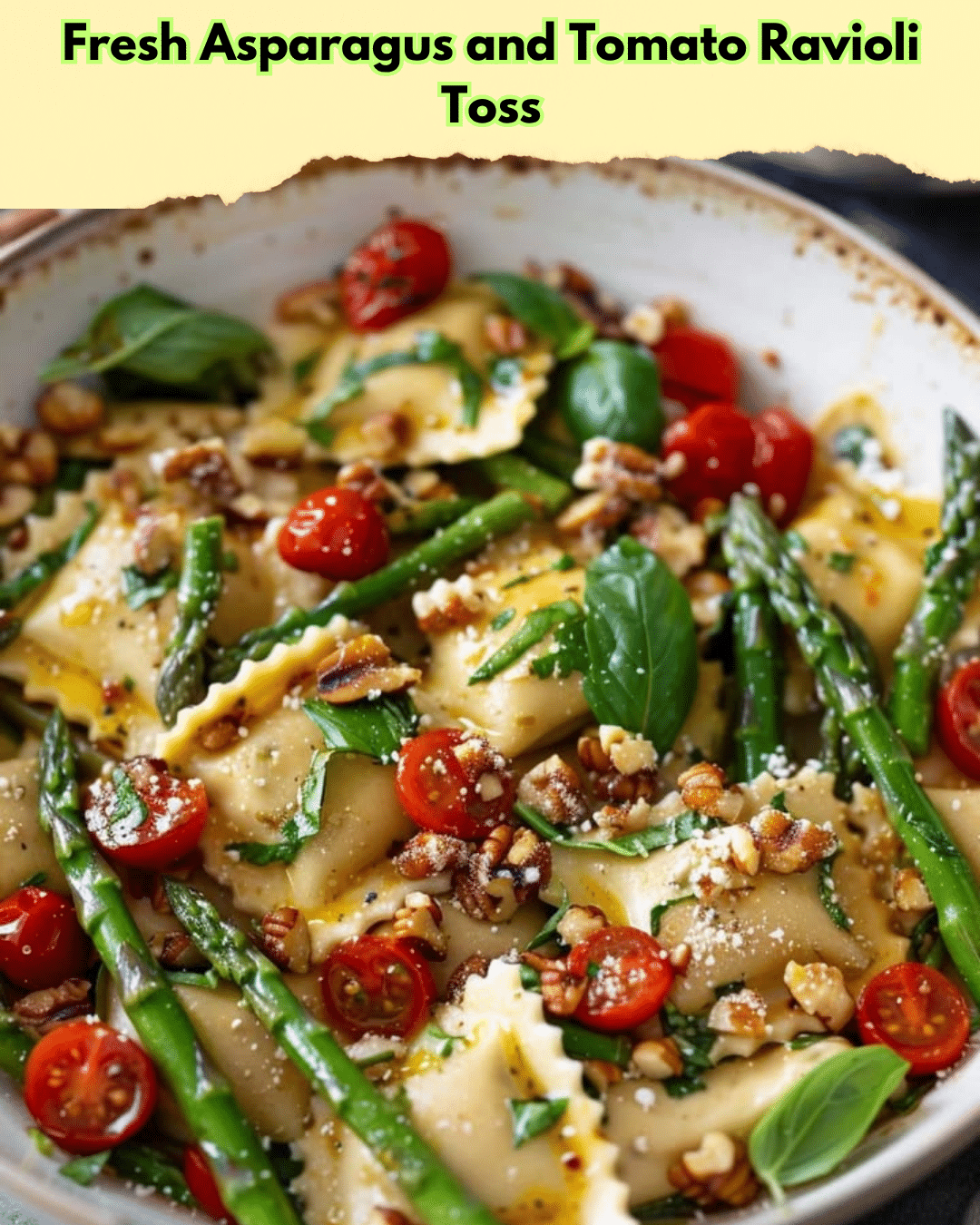Fresh Asparagus and Tomato Ravioli Toss: A Delightful Spring Dish
This fresh asparagus and tomato ravioli toss is a symphony of spring flavors, marrying the delicate taste of tender asparagus with the vibrant punch of cherry tomatoes. The homemade ravioli brings an Italian touch to this breezy recipe, while freshly grated Parmesan cheese adds a savory depth. Whether you’re preparing a quick weeknight meal or hosting a brunch with friends, this dish manages to be both sophisticated and soothing, making it a seasonal favorite. The ease of preparation and the pleasant texture harmony make this asparagus and tomato ravioli toss an exceptional choice for pasta lovers seeking freshness and simplicity.
Quick Recipe Highlights
- Flavor Profile: This dish features a light, fresh taste with the gentle earthiness of asparagus and the sweet-tart pop of cherry tomatoes.
- Texture: The combination of al dente ravioli, crisp asparagus, and soft, juicy tomatoes provides a satisfying blend of textures.
- Aroma: The dish carries a fresh, green scent from the asparagus, complemented by the soothing aroma of fresh basil and garlic.
- Visual Appeal: A vibrant medley of green asparagus and red tomatoes scattered over golden ravioli makes this dish a feast for the eyes.
- Skill Level Needed: Perfect for cooks at any level, requiring only basic culinary skills to pull together.
- Special Equipment: No special tools are needed beyond a pot for boiling ravioli and a pan for the sauce.
Recipe Overview
- Difficulty Level: This recipe is straightforward, making it approachable for novice cooks. The steps involve simple boiling and sauting techniques.
- Category: This is a main course that works well for lunch or dinner, easily adapting to both family meals and entertaining.
- Cuisine: Italian-inspired, this dish highlights classic Mediterranean ingredients with a fresh, modern twist.
- Cost: Moderate; the primary ingredients are affordable, although using high-quality ravioli may incrementally increase the cost.
- Season: Best made in spring when asparagus is in peak season, ensuring the freshest flavor.
- Occasion: This dish is versatile enough for casual weeknight meals or more formal gatherings like a spring brunch or alfresco dinner party.
Why You’ll Love This Recipe
Fresh asparagus and tomato ravioli toss is a symphony of flavors and textures, with each bite offering the perfect balance of tender pasta, crunchy asparagus, and juicy tomatoes. The freshly grated Parmesan cheese adds the finishing touch of savory umami. This dish not only appeals to the taste buds but also provides a rich contrast of textures, making it an enjoyable eating experience.
Preparation is a breeze, requiring minimal time in the kitchen, which makes it a perfect choice for weeknight dinners. With easy-to-follow steps, this recipe doesn’t necessitate advanced cooking skills, allowing everyone to create a restaurant-quality dish in the comfort of their home.
Nutritionally, asparagus and tomatoes are both powerhouse ingredients rich in vitamins and antioxidants. Asparagus provides dietary fiber and folate, while tomatoes offer vitamin C and lycopene. Paired with the protein-rich ravioli, this dish is as nourishing as it is delicious.
Socially, this dish is versatile enough to feature as a brunch centerpiece or as a casual gathering offering. Its colorful presentation and fresh aromas make it an instant crowd-pleaser. Pairing it with crisp white wine or sparkling water adds elegance to any dining setup.
Cost-effectively, this recipe leverages seasonal produce, allowing you to enjoy fresh flavors without breaking the bank. The core ingredients are readily accessible, making it an easy choice for those seeking to balance quality with cost.
Historical Background and Cultural Significance
The pairing of asparagus and tomatoes with ravioli leans on the rich culinary heritage of Italian cuisine, where simple, fresh ingredients take center stage. Historically, asparagus was revered in Mediterranean cultures, prized not only for its taste but for its symbol of luxury and refinement.
Culturally, ravioli has roots dating back to the 14th century, believed to be a staple in the diets of Venetian merchants. The versatility that ravioli offers embodies the essence of Italian adaptability and creativity in the kitchen, which is beautifully represented in this recipe.
The evolution of this dish represents a modern twist on traditional ingredients. As more people embrace lighter, plant-focused meals, the asparagus and tomato ravioli toss effortlessly fits into contemporary dietary trends that prioritize taste and health.
Regional variations can be found throughout Italy, with northern regions incorporating cream-based sauces and southern areas emphasizing tomato-centric combinations. This recipe captures the southern flair, highlighting the freshness and natural sweetness of cherry tomatoes and asparagus.
Ingredient Deep Dive
The star ingredient, asparagus, boasts a rich history dating back to ancient Greece and Egypt. Not only does it add a distinct flavor profile to this dish, but it also offers significant nutritional benefits, including fiber and vitamins A, C, and K. When selecting asparagus, look for firm, straight stalks with closed tips. Store it upright in the refrigerator, immersing the base in a bit of water to maintain freshness.
Cherry tomatoes, another key component, provide sweetness and a juicy burst of flavor. Packed with vitamin C and antioxidants like lycopene, they are essential for adding complexity to the dish. When choosing tomatoes, opt for ones that are firm and bright red for peak quality. To store, keep them at room temperature to preserve flavor.
When substituting ingredients, broccolini can replace asparagus for a slightly different texture, while sun-dried tomatoes can be used when fresh cherry tomatoes are unavailable, adding an intense and deeper tomato flavor.
Common Mistakes to Avoid
- Overcooking the asparagus: This can result in a mushy texture. Always check for a slight crispness that indicates proper doneness.
- Under-seasoning: Fresh ingredients deserve adequate seasoning with salt and pepper to enhance their natural flavors.
- Using dried basil: The recipe calls for fresh basil, which offers a sweet and aromatic flavor that dried can’t match.
- Overcooking the ravioli: Be sure to follow package instructions closely; al dente ravioli has the best mouthfeel.
- Skipping the cheese: The Parmesan cheese not only adds flavor but also contributes to the dish’s creamy texture.
- Using old tomatoes: Cherry tomatoes add freshness, so ensure they are ripe and juicy.
- Ignoring the sauce: A gentle toss is enough; over-mixing can break the ravioli apart.
- Not tasting as you go: Flavors develop, so adjust seasonings according to taste preferences throughout the process.
Essential Techniques
Mastering the saute technique is crucial for cooking the asparagus perfectly. This method involves cooking the asparagus quickly over high heat to achieve a tender exterior and crunchy interior, which adds essential texture to the dish. Keep an eye on the visual cues; vibrant green color signals that the asparagus is ready.
Creating the perfect ravioli boil is another cornerstone of this recipe. A gentle simmer is required to avoid ravioli bursting. Once floated, test one for doneness, ensuring it’s cooked al dente for optimal texture.
Tossing is the final key technique—it requires gentle folding to combine asparagus, tomatoes, and ravioli evenly without breaking the pasta. A gentle hand will incorporate all elements while maintaining the integrity of each ingredient.
Pro Tips for Perfect Fresh Asparagus and Tomato Ravioli Toss
Choose fresh, high-quality ingredients for the best flavor. Fresh asparagus and ripe tomatoes are crucial for this dish to shine.
Blanch your asparagus in boiling water before sauting to lock in vibrant color and boost tender-crisp texture.
Use a large pan for even sauteing, allowing the asparagus and tomatoes to cook without overcrowding, ensuring proper caramelization.
For enhanced flavor, add a dash of white wine to the sauce, letting the alcohol cook off to leave behind rich undertones.
Finish the dish with a drizzle of quality olive oil for added richness and a sprinkle of freshly grated Parmesan cheese for an elegant touch.
Gently fold ingredients with kitchen tongs to maintain the integrity of the ravioli and ensure even distribution throughout the sauce.
Variations and Adaptations
Regional variations can be explored by switching up the sauce base; substituting a light cream sauce for a southern Italian twist, or integrating mushrooms for umami depth.
For seasonal adaptability, replace asparagus with zucchini or squash in summer months or kale in autumn while retaining the sit-down meal’s fresh appeal.
Dietary modifications are simple; use gluten-free ravioli for those with gluten sensitivities or opt for vegan cheese alternatives to maintain a plant-based dish.
Adding flavor is straightforward, such as incorporating chili flakes for heat or lemon zest for a citrusy finish, allowing easy customization to personal preferences.
To modify texture, toss in walnuts or pine nuts for added crunch, enhancing both taste and mouthfeel.
Presentation alternatives include serving as a cold pasta salad or arranging on a platter for an artisanal-style presentation conducive to family-style dining.
Serving and Presentation Guide
For elegant presentation, serve the ravioli on a wide, flat platter, arranging asparagus and tomatoes artfully around the pasta.
Enhance the dish’s visual appeal by garnishing with fresh basil leaves and a sprinkle of Parmesan cheese for color contrast and flavor enhancement.
Traditional accompaniments include a side salad with peppery arugula or rustic bread to mop up residual sauce, heightening the dining experience.
For a modern twist, stack the ravioli in portions using a ring mold, topped with the asparagus and tomato mixture for a restaurant-quality look.
Serve slightly warm for optimal flavor release, ensuring the ingredients complement each other rather than being lost in heat.
Exercise portion control by serving six raviolis per plate, balanced with generous amounts of vegetables to ensure a satisfying, not overwhelming, dish.
Wine and Beverage Pairing
Light, crisp white wines such as Pinot Grigio or Sauvignon Blanc make excellent pairings, accentuating the dish’s freshness and vibrant flavors.
For non-alcoholic options, consider sparkling water infused with lemon or a chilled herbal tea like peppermint to cleanse the palate between bites.
Complement the meal with iced tea lightly sweetened with honey or invigorating lemon ginger tea for beverage diversity and aromatic harmony.
Ensure beverages are served chilled to offset the dish’s warmth, maintaining a refreshing balance throughout the meal.
For best results, serve drinks in clear glassware to appreciate the visual aesthetics of the pairing alongside the meal’s vibrant presentation.
Storage and Shelf Life
Proper storage is essential for maintaining the dish’s integrity. Refrigerate leftovers in an airtight container, ensuring freshness for up to three days.
Keep storage containers in the coldest part of the fridge to prolong shelf life and prevent spoilage, checking temperatures regularly.
Watch for signs of spoilage, including off odors or discoloration. If they appear, discard to avoid foodborne illness.
When reheating, use a low-power microwave or pan with a splash of stock to prevent drying out the ravioli, preserving taste and texture.
If freezing, place ravioli, asparagus, and tomatoes in separate freezer-safe bags, label with dates, and consume within one month for optimal quality.
Make Ahead Strategies
To streamline preparation, wash and trim the asparagus and tomatoes a day ahead, storing them separately in airtight containers to maintain freshness.
Prepare ravioli according to package instructions and store in a lightly oiled container to prevent sticking, cutting down prep time on the day of serving.
Assess dish quality post-storage by tasting for retained flavor profiles, adjusting with fresh herbs or a squeeze of citrus to freshen.
Assemble by laying out ingredients on a tray, ready to toss in a prepared pan, minimizing last-minute assembly stress.
When reheating, add stock or a light broth to invigorate flavors and maintain moisture, ensuring the dish tastes freshly made.
Incorporate fresh elements like basil leaves just before serving to enhance flavor and visual appeal, refreshing the dish instantly.
Scaling Instructions
To halve the recipe, decrease ingredient quantities proportionally, paying close attention to seasoning to preserve flavor balance.
For larger gatherings, doubling or tripling is straightforward, but incorporate additional sauce or broth to ensure even coating and retention of taste.
Consider equipment adjustments such as larger pans or two simultaneous saucepans to accommodate increased volumes without overcrowding.
Timing modifications may be necessary with scale changes—monitor cooking times closely to prevent overcooking when working with larger batches.
Make storage considerations by preparing extra containers for leftovers, labeled appropriately for post-event usage or freezing.
Nutritional Deep Dive
With a macro breakdown highlighting balanced carbs and proteins from ravioli and vegetables, this dish supports daily nutritional needs.
Micronutrient-rich, the asparagus yields dietary fiber and folate while tomatoes provide antioxidants like lycopene, beneficial against oxidative stress.
This dish offers health benefits by being low in saturated fat and sodium, supporting heart health and weight management through mindful ingredient selection.
Portion analysis reveals a meal rich in essential vitamins and minerals, fostering energy levels and promoting overall well-being when included in a balanced diet.
Specific dietary considerations, like monitoring for gluten in ravioli, help tailor this meal for specific needs and promote inclusivity at dining events.
Dietary Adaptations
For a gluten-free approach, substitute traditional ravioli with certified gluten-free variants available at specialty stores or homemade options.
To make this recipe dairy-free, use nutritional yeast instead of Parmesan for a similar umami effect with plant-based benefits.
Adopt a vegan lifestyle easily by using tofu-filled ravioli and excluding cheese, incorporating nutritional yeast and cashew cream for taste complexity.
Adjust to a low-carb diet by swapping ravioli for zoodles (zucchini noodles) while keeping the asparagus and tomato mix constant for flavor continuity.
Keto adherence is achievable by using almond flour-based ravioli alternatives and emphasizing high-fat toppings like avocado slices to fit macros.
Adapt for a Paleo lifestyle by excluding pasta, prioritizing vegetables, and adding lean protein such as grilled chicken for satisfying sustenance.
Troubleshooting Guide
Smooth out texture issues by ensuring ravioli is cooked al dente, resisting the urge to over-boil, which compromises structure and appeal.
Address flavor imbalances by adjusting seasonings, offering more lemon zest or pepper as needed to brighten or tone down the dish.
Manage temperature problems typically caused by overcrowding during reheat—a single layer ensures even warming throughout the dish.
Navigate equipment challenges with sturdy pans that heat evenly, crucial for consistent cooking of the asparagus and sauce components.
Handle ingredient substitutions like zucchini for asparagus with care, ensuring equivalent cut sizes and cooking times for uniformity.
Address timing concerns by maintaining workspace organization, prepping ingredients in advance, and allotting sufficient cook times for each step.
Recipe Success Stories
Readers rave about the ease and flavor of the fresh asparagus and tomato ravioli toss, with many adapting the recipe for personal events, like baby showers or office parties, often praised for its fresh taste and visual allure.
Community feedback suggests adding prosciutto for those who enjoy a salty kick, shared across social media platforms with glowing reviews and mouthwatering images.
Homemade ravioli success stories show personalization of flavors and creativity in fillings, with variations embraced by culinary enthusiasts.
Suggestions from readers recommend experimenting with herbs like dill or mint for unique twists—proof of the recipe’s adaptability to individual palates.
Photography tips from readers capture the dish’s vibrant colors under natural light, presenting an inviting dish that’s as visually appealing as it is delicious.
Frequently Asked Questions
Can I use frozen ravioli for this recipe?
Yes, frozen ravioli can be used. Just add a few extra minutes to the cooking time as indicated on the package to ensure it cooks through properly.
What if I can’t find fresh asparagus?
Substitute with broccolini or green beans for a similar texture and flavor, ensuring they are cooked to crispiness for best results.
Is there a vegan cheese I can use if I’m eliminating dairy?
Nutritional yeast is an excellent substitute for Parmesan, providing a cheesy flavor without animal products.
How should I adjust for higher altitudes?
Increase boiling and cooking times slightly due to lower boiling point and atmospheric pressure, checking frequently for doneness.
What wine pairs best with this dish?
A crisp Sauvignon Blanc or light Pinot Grigio complements the fresh notes of asparagus and tomato beautifully.
How can I keep leftovers from getting soggy?
Store components separately—if possible, with ravioli on a paper towel-lined container to absorb excess moisture before reheating.
Can I freeze this dish?
Yes, freeze the components separately; consider preparing fresh ingredients like tomatoes and basil upon reheating for freshness.
What are some suitable side dishes?
Serve with a light salad of arugula and lemon vinaigrette or toasted garlic bread for texture contrast.
How do I prevent tomatoes from losing their shape?
Add tomatoes late in the cooking process, allowing them to heat through without overcooking, maintaining their structural integrity.
How can I add protein to this dish?
Incorporate grilled chicken strips or chickpeas for vegetarian options, seamlessly increasing protein content.
Additional Resources
Explore the art of making fresh pasta with our step-by-step guide to elevate any ravioli dish to artisan heights, offering knowledge to complement this recipe’s simplicity.
Delve deeper into seasonal ingredient selection, spotlighting the finest local produce, ensuring fresh asparagus and tomatoes are perennial staples, ripe for creative recipes.
Discover must-have kitchen equipment recommendations to streamline your asparagus and tomato ravioli toss preparation, highlighting tools enhancing efficiency and ease.
Reference expanded culinary techniques for perfect sautéing and blanching, ensuring asparagus captures the ideal tender-crisp texture needed for premium execution.
Adapt seasonal variations with ideas for integrating fall and winter produce, maintaining ingredient inspiration and recipe vitality year-round, offering dynamic culinary experiences.
Print
Fresh Asparagus and Tomato Ravioli Toss
Description
A delightful and fresh pasta dish combining tender asparagus, sweet cherry tomatoes, and cheese-filled ravioli, perfect for a springtime meal.
Ingredients
For the Crust:
- 12 ounces cheese ravioli
- 1 pound asparagus, trimmed and cut into 2-inch pieces
- 1 cup cherry tomatoes, halved
- 3 cloves garlic, minced
- 2 tablespoons olive oil
- Salt and pepper to taste
- 1/4 cup grated Parmesan cheese
- Fresh basil leaves for garnish
Instructions
1. Prepare the Crust:
- Cook the ravioli according to package instructions; drain and set aside.
- In a large skillet, heat olive oil over medium heat. Add garlic and cook until fragrant, about 1 minute.
- Add asparagus and cherry tomatoes to the skillet, season with salt and pepper, and cook until asparagus is tender-crisp, about 5-7 minutes.
- Add the cooked ravioli to the skillet, toss gently to combine with the vegetables, and heat through.
- Sprinkle with grated Parmesan cheese and garnish with fresh basil leaves before serving.
Notes
You can customize the seasonings to taste.




